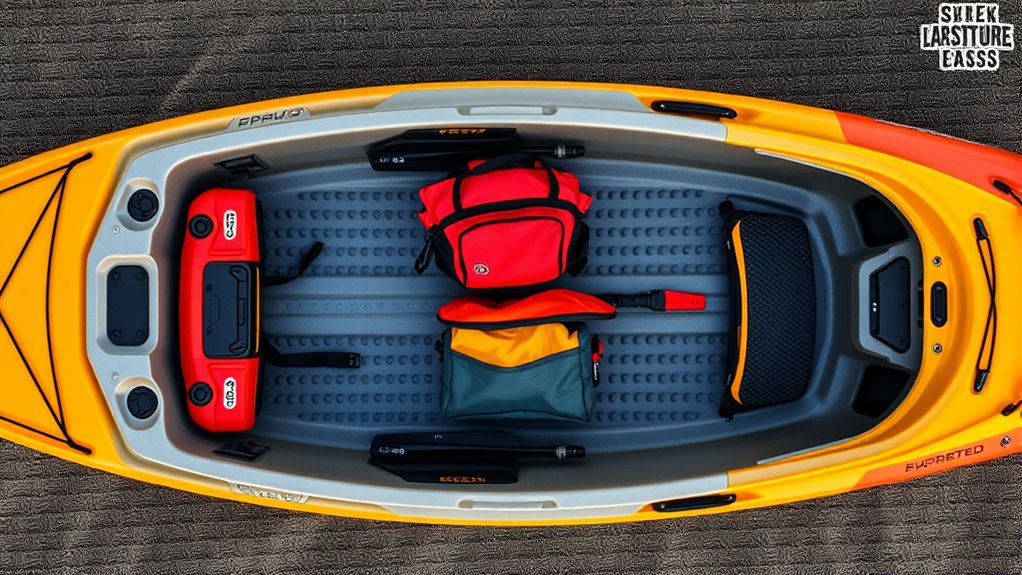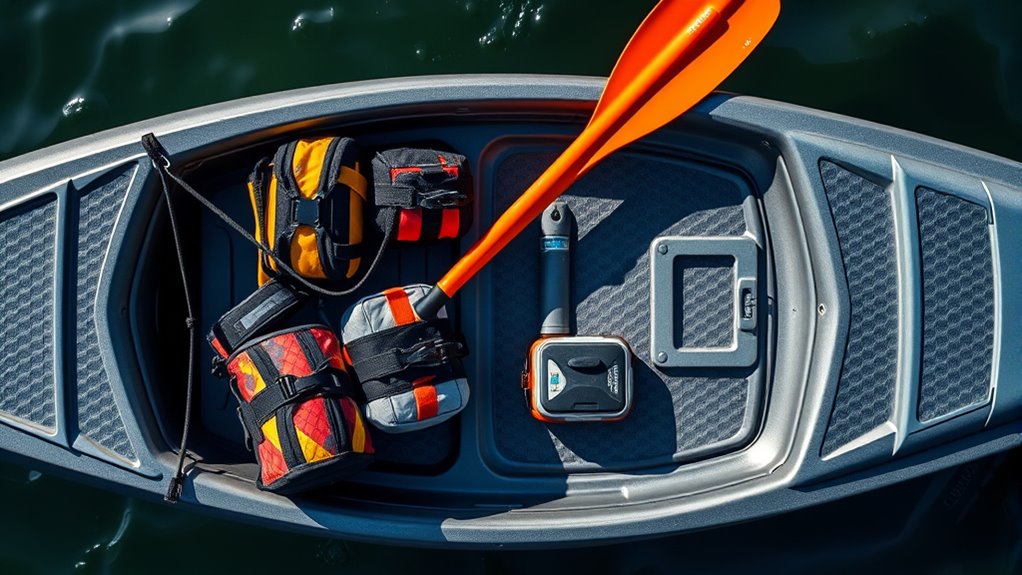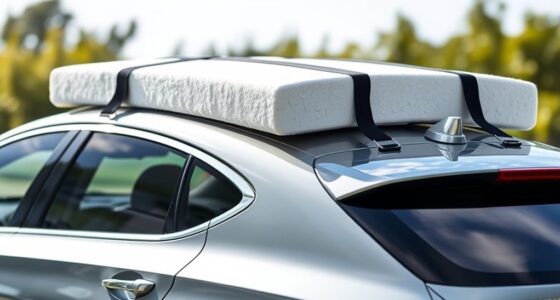To maximize quick gear access on your kayak, design your deck layout with strategically placed storage compartments and paddle holders. Position smaller, sealed storage boxes within easy reach from your seated position, especially behind the seat or on side panels. Mount paddle holders on the sides for quick grab-and-release. Guarantee these features align with your paddling rhythm, reducing unnecessary movements and fatigue. Keep exploring to discover more tips on creating an efficient, organized kayak deck setup.
Key Takeaways
- Strategic placement of storage compartments behind the seat or on side panels for easy reach.
- Side-mounted paddle holders positioned for quick access during paddling breaks.
- Layout designs aligning with natural paddling motion to prevent interference and reduce fatigue.
- Multiple small compartments along the deck for segregating gear like safety items and snacks.
- Organized, clutter-free deck design to facilitate rapid access and enhance paddling efficiency.

Have you ever wondered how kayak deck layouts are designed to optimize your paddling experience? It’s all about strategic placement—making sure your gear is within reach without hindering your movement. When you step onto a kayak, you want quick access to essentials like water, snacks, or safety equipment, and the layout plays a crucial role in that. Well-designed kayaks feature dedicated storage compartments that are easily accessible from your seated position. These compartments are typically sealed to keep gear dry and secure, yet positioned conveniently so you don’t have to stretch or lean uncomfortably to reach them. Whether it’s a hatch behind your seat or a side storage pocket, these compartments are vital for keeping your gear organized and within arm’s reach.
Paddle holders are another critical element in effective deck layouts. They’re usually mounted on the sides of the kayak, enabling you to secure your paddle when you need a break or want to free your hands momentarily. Proper paddle holders are positioned so you can grab your paddle swiftly without fumbling or risking losing control. They’re adjustable to accommodate different paddle sizes and can be easily released when you’re ready to resume paddling. With paddle holders in place, you reduce the risk of losing your paddle overboard and keep your deck clear for other gear or movement.
The placement of these features isn’t accidental. Good kayak deck layouts consider your natural paddling motion, ensuring that storage compartments and paddle holders don’t interfere with your stroke. They’re often located in areas that you can access without having to twist or reach behind your back. This design minimizes fatigue and maximizes efficiency on the water. Many kayaks also incorporate multiple smaller compartments along the sides or near the cockpit, allowing you to segregate items like a first-aid kit, phone, or fishing tackle. These are positioned so you can quickly grab what you need without disrupting your paddling rhythm.
Frequently Asked Questions
How Do Deck Layouts Vary for Different Kayak Types?
Different kayak types have varied deck layouts to suit their functions. For example, touring kayaks prioritize accessory placement for navigation and safety gear, while fishing kayaks emphasize storage capacity for tackle and supplies. You’ll find that sit-on-top models often have accessible storage hatches, whereas sit-inside kayaks focus on streamlined designs. These variations help you optimize gear access and storage, making your paddling experience safer and more convenient based on your activity.
Can Deck Layouts Be Customized After Purchase?
Yes, you can customize deck layouts after purchase to fit your needs. Many kayaks feature adjustable storage, allowing you to reposition or add compartments for quick gear access. Additionally, accessory compatibility enables you to attach or modify elements like rod holders or tie-downs. This flexibility helps you tailor your kayak’s layout, ensuring you have the most efficient setup for your adventures and gear management.
What Safety Considerations Influence Deck Storage Placement?
Imagine losing crucial gear when you need it most. That’s why storage safety and gear security are essential in deck storage placement. You should position heavy, vital items lower and close to your center for stability and quick access. Avoid clutter that could shift or fall, risking injury. Prioritize secure bungee cords or straps, and keep dangerous tools out of reach. Proper placement ensures safety and peace of mind on every trip.
How Does Deck Layout Affect Kayak Stability?
Your kayak deck layout directly impacts stability, especially when you’re attaching fishing accessories or paddle storage. A well-balanced setup keeps the center of gravity low and evenly distributed, preventing tipping. Proper placement of gear guarantees you don’t shift your weight unexpectedly. By organizing fishing accessories within easy reach and securing paddle storage properly, you maintain better stability, making your paddling experience safer and more enjoyable.
Are There Universal Deck Designs Suitable for All Kayakers?
You might wonder if there’s a universal deck design suitable for all kayakers. While some universal designs offer adaptive configurations to accommodate various gear and skill levels, no single layout fits everyone perfectly. Your choice depends on your kayaking style, gear needs, and preferences. Look for flexible, adaptive configurations that can be customized, ensuring you get the best setup for your adventures, regardless of kayak type or experience.
Conclusion
By understanding kayak deck layouts, you turn your boat into a well-organized symphony of accessibility, where every gear piece plays its part effortlessly. Think of your deck as a trusted map guiding you through the waters, ensuring quick access when moments matter most. With a smart layout, you’re not just paddling—you’re gliding through your adventure like a swift falcon, confident and in control. Embrace the setup, and let your kayak become an extension of your adventurous spirit.










